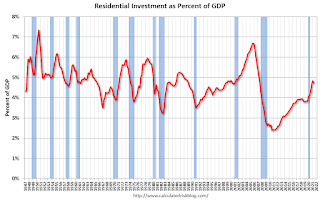by Calculated Risk on 7/29/2021 09:14:00 AM
Thursday, July 29, 2021
A Few Comments on Q2 GDP
Earlier from the BEA: Gross Domestic Product, Second Quarter 2021 (Advance Estimate) and Annual Update
Real gross domestic product (GDP) increased at an annual rate of 6.5 percent in the second quarter of 2021, according to the "advance" estimate released by the Bureau of Economic Analysis. In the first quarter, real GDP increased 6.3 percent (revised).On a Q2-over-Q2 basis, GDP was up 16.7% (Q2 2020 was the depth of pandemic recession).
emphasis added
 Click on graph for larger image.
Click on graph for larger image.This graph shows the percent decline in real GDP from the previous peak (the previous peak was in Q4 2019).
This graph is through Q1 2022, and real GDP is now at a new peak; 0.8% above the previous peak.
The advance Q2 GDP report, at 6.5% annualized, was below expectations, due to several factors - a decline in private inventories, a decline in residential investment, a decline in government expenditures and a negative contribution from trade.
Personal consumption expenditures (PCE) increased at a 11.8% annualized rate in Q2, due, in part, to the American Rescue Plan Act.
The second graph below shows the contribution to GDP from residential investment, equipment and software, and nonresidential structures (3 quarter trailing average). This is important to follow because residential investment tends to lead the economy, equipment and software is generally coincident, and nonresidential structure investment trails the economy.
In the graph, red is residential, green is equipment and software, and blue is investment in non-residential structures. So the usual pattern - both into and out of recessions is - red, green, blue.
Of course - with the sudden economic stop due to COVID-19 - the usual pattern doesn't apply.
The dashed gray line is the contribution from the change in private inventories.
 Residential investment (RI) decreased at a 9.8% annual rate in Q2. Equipment investment increased at a 13.0% annual rate, and investment in non-residential structures decreased at a 7.0% annual rate (after getting crushed over the previous year)..
Residential investment (RI) decreased at a 9.8% annual rate in Q2. Equipment investment increased at a 13.0% annual rate, and investment in non-residential structures decreased at a 7.0% annual rate (after getting crushed over the previous year)..The contribution to Q2 GDP from investment in private inventories was -1.13 percentage points (this will likely be a positive in the second half of 2021).
On a 3 quarter trailing average basis, RI (red) is still up solidly, equipment (green) is up sharply, and nonresidential structures (blue) is still down.
On a 3 quarter trailing average basis, RI (red) is still up solidly, equipment (green) is up sharply, and nonresidential structures (blue) is still down.
I'll post more on the components of non-residential investment once the supplemental data is released.
 The third graph shows residential investment as a percent of GDP.
The third graph shows residential investment as a percent of GDP.
Residential Investment as a percent of GDP decreased in Q2, after increasing sharply for several quarters.
I'll break down Residential Investment into components after the GDP details are released.
Note: Residential investment (RI) includes new single family structures, multifamily structures, home improvement, broker's commissions, and a few minor categories.
 The fourth graph shows non-residential investment in
structures, equipment and "intellectual property products".
The fourth graph shows non-residential investment in
structures, equipment and "intellectual property products".
 The third graph shows residential investment as a percent of GDP.
The third graph shows residential investment as a percent of GDP.Residential Investment as a percent of GDP decreased in Q2, after increasing sharply for several quarters.
I'll break down Residential Investment into components after the GDP details are released.
Note: Residential investment (RI) includes new single family structures, multifamily structures, home improvement, broker's commissions, and a few minor categories.
 The fourth graph shows non-residential investment in
structures, equipment and "intellectual property products".
The fourth graph shows non-residential investment in
structures, equipment and "intellectual property products".
Investment in non-residential structures declined in Q2 as a percent GDP, and will probably be weak for some time (hotel occupancy is still low, office and mall vacancy rates are high).


